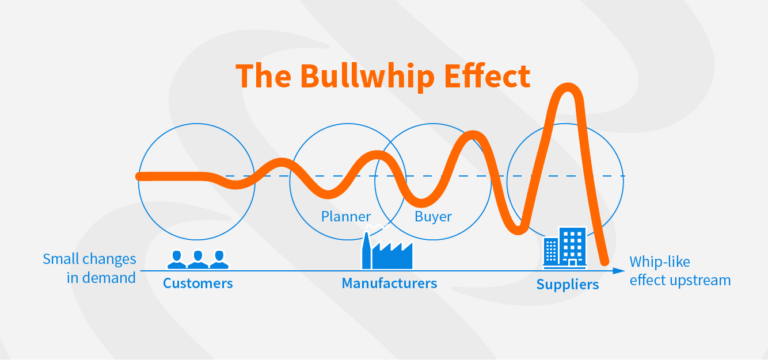One of the reasons why the bullwhip effect has been a huge obstacle for manufacturers for decades—and why so much energy is devoted to solving it—is because it shows how rational decision makers can make things worse by trying to do their best. After all, planning and forecasting is supposed to be the way to solve production, supply, and storage issues.
But what we’re currently seeing with the prolonged impacts of the Covid-19 pandemic on manufacturing and shipping capacity all over the globe is that variations in demand are being magnified more than ever before by forecasts that can’t react and adjust dynamically to changing conditions.

As Crister Carlsson and Robert Fuller explained in their 2000 paper on how to tame the bullwhip, creating faster and more accurate signals between manufacturers and their suppliers are the likely key to addressing and solving the issue that leads to both excess inventory and increased shortages impacting customer on-time delivery:
"Let’s assume that the retailer gets a much higher demand in one period. This will be interpreted as a signal for higher demand in the future, the demand forecasts for future periods get adjusted, and the retailer reacts by placing a larger order with the wholesaler. As the demand is non-stationary, the optimal policy of ordering also gets non-stationary. A further consequence is that the variance of the orders grows, which is starting the bullwhip effect. If the lead-time between ordering point and the point of delivery is long, uncertainty increases and the retailer adds a 'safety margin,' which will further increase the variance and add to the bullwhip effect… The effect gets started by rational decision making, i.e. by decision makers doing the best they can. In other words, there is no hope to avoid the bullwhip effect by changing the ordering policy."
More than two decades later, the same principles exist behind the cause of the bullwhip effect and the problem is getting worse. Products are getting more complex with increasing levels of customization while the supply chain providing these critical components is more global than ever before. Coordinating the delivery of these parts to complex assemblies to meet highly specific consumer demand takes far more coordination of production, delivery and management of smaller-quantity components, with scarcity of one part creating a holdup that adds momentum to the bullwhip effect.
Richard Lebovitz, CEO and founder of LeanDNA, said the growing supply chain complexity caused by increasing mass customization and supplier globalization has magnified the importance of leveraging collaborative analytics to establish synchronized and prioritized demand signals across planning, procurement, and supply.
Another factor, the shift from vertical integration to horizontal integration in manufacturing, has created major challenges for supply chain leaders as they work to manage the procurement of an increasing number of SKUs across an expanding global supply base.
This requires advanced analytics built upon a universal data model that can connect siloed systems into a common platform where manufacturing sites and their suppliers are able to prioritize their procurement activities around a single source of truth.
"At the core of today’s supply chain is a series of connected factories with a variety of systems being used to provide the critical delivery signals and supply chain management to get products actually made. As demand fluctuates, the current ERP systems will often provide material buyers and planners with anywhere from 50 to 500 messages every single day notifying them to cancel certain parts, order other parts, or to expedite orders. Procurement teams are overwhelmed with conflicting data and priorities, and the result is a series of siloed decision making that is a key driver of the bullwhip effect."
"What they need to know is what are the five or ten signals that will have the most impact each day, and this prioritization of information needs to be communicated across the supply chain tiers. At LeanDNA, we directly connect planners, buyers, and suppliers across a common set of priorities so that everyone is synchronized across a shared set of goals that will optimize inventory while improving customer on-time delivery. When people are prioritizing the right actions and communicating these needs across all levels of the supply chain, that's what starts to tamp down that bullwhip effect"

Richard Lebovitz
Founder and CEO of LeanDNA
A reliance on old-fashioned spreadsheets remaining as the trusted management method for veteran site managers is another factor that keeps the bullwhip effect in place.
Lebovitz said companies that use a series of disconnected ERP systems lack the ability to communicate with each other in a sophisticated way across different sites to manage demand to match what the market is signaling it needs.
"Today’s manufacturing executives can see the problem, but the growing complexity in both the physical supply chain and management systems is creating delays in executing on the optimal solutions and what exact problems need to be solved. The problem is that most supply chain leaders are overwhelmed with multiple disconnected systems that focus on showing past performance, but fail to provide guidance on how to actually make improvements moving forward and what specific actions need to be taken across their end-to-end horizontal supply chain. While all these spreadsheets, BI Tools, or homegrown solutions have created marginal gains, they are no longer effective in today’s increasingly complex environment."
"The LeanDNA planform prioritizes what needs to be done each day around procurement of the supply chain, and then connecting that to the people that really need that information. Those are some of the unique insights that most companies don't have. As we release our product to help surface those priorities, the ability to connect more suppliers with the right information becomes possible."

Richard Lebovitz
Founder and CEO of LeanDNA
Want to get ahead of the bullwhip effect?
Supply chain disruptions and shortages are inevitable. Get your teams out of firefighting mode with the Shortage Attack Kit, including best practices and information about prioritizing, preventing, and attacking shortages during today’s unpredictable supply and demand.
